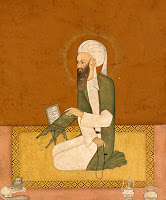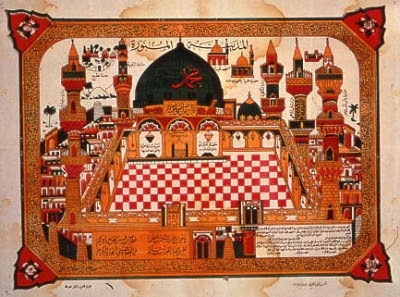From
632 to 661, in a spanned of just 30 years, an empire emerged on the back of a rising
religion – Islam. This spectacular expansion of territory and religion came
under the leadership of the deputies of Islam’s founder Mohammed – the Rashidun
Caliphs.
Early Existence
The
Prophet Mohammed passed away in 632 and left a Muslim community in Mecca and
Medina bent on spreading the religion either through by peace or war. He left
no instruction as to who would succeed him as the leader of the new community.
The Companions of the Prophet thought of this issue deeply when they met in
Medina. They immediately disregarded passing the leadership to the children of
the Prophet due to their gender – 4 daughters. Alas, they had to choose between
acknowledging as their leader the male relatives of the Prophet or through
election. This contention later sow the seeds of the demise of the Rashidun
Caliphate.
 |
| Abu Bakar |
Eventually,
they chose an election and this Abu Bakar al-Siddiq (r. 632 – 634), one of the
earliest apostle of the Prophet, emerge as their new leader. He along with his
4 successors came to be known as Rashidun Caliphs or the Rightly Guided. They
took the title Kalifa or Caliph meaning deputy with the task of leading the
Islamic community forward. Abu Bakar had the respect of many because he was
among the earliest converts of Islam. He also earned confidence the same way as
the Prophet showed him chosing him while the latter was ill.
Abu
Bakar met an immediate daunting task. Although the Muslim community stood
strong and growing after the death of Mohammed, some Arab tribes, however,
chose to leave Islam and revert back to their old religions. They also refused
to pay taxes to Medina viewing the Prophet’s death as the end of their pledge
of allegiance and obligation towards the polity he left. Abu Bakar must then
reassert Islam’s rule over these tribes through war that became known as
al-Ridda War.
The
new Caliph Abu Bakar proved himself a great leader. He won the al-Ridda War and
the Peninsula became totally controlled by Islam. The reach of the religion
also expanded beyond the Arabian dessert and in time gained new converts in
neighboring countries such as Yemen.
Internally,
Abu Bakar organized the government of his caliphate and a standing army bent in
spreading Islam through a Jihad or Holy War against infidels or non-Muslims.
Abu Bakar, however, failed to see the expansion. He passed away in 634, ruling
only for 2 years but he secured a strong foundation for the Rashidun Caliphate
to build from.
Expansion
After
Caliph Abu Bakar’s demise, the Companions of Mohammed met once again for an
election. This time, Umar ibn al-Khattab (r. 634 – 644), went to be the winner
and the 2nd Rashidun Caliph. His rule saw military expansion against their
powerful neighboring empires of Byzantine and Sassanid.
Umar
came from a humble background and not as prominent as other Companions. He appeared
as a humble and honest leader and a strong military commander proven by
entering a war against the empires of the Christian Byzantines and Zoroastrian
Sassanids. His choice to attack the 2 empires came timely as both had been
tired from decades of fighting each other. Thus, the growing incursions of the
Muslims in the borders immediately became a cause for concern for the empires.
In
634, the great General Khalid ibn al-Walid led his army to victory against the
Sassanids in the Battle of the Chains. Such the battle’s name due to the
Persians army soldiers wearing a chain in their feet to prevent their
desertion. After this major victory, another followed, this time against the
Byzantines. The magnitude of Muslim attacks grew from raids to a major
invasion. In 636, a Muslim army under Generals Khalid ibn al-Walid and Abu
Ubaidah bin Jarrah fought an army way larger than theirs in the lengthy Battle
of Yarmuk. The battle ended with a complete Muslim victory and the whole of the
Levant, including the Holy City of Jerusalem, and Egypt came under the fold of
the Rashidun Caliphate. The 3 Holy Cities in Islam – Mecca, Medina, and
Jerusalem – was finally under the control of the Rashiduns.
More
victories followed Yarmouk. In 637, the Battle of Qadisiya against the Sassanid brought Iraq and parts of Persia under the Muslims. A year later the Sassanid capital
of, Ctesiphon, fell to Muslim commander Saad al-Waqqas. In 641, ancient cities
of Mosul and Babylon fell to the Arabs after the Battle of Nahavand. The
Sassanid King fled and avoided capture for years to come.
 |
| Taq-i Kisra in Ctesiphon |
A
key to the success of the Muslim expansion seemed to be their religious tolerance.
Unlike the Persian Sassanids and Byzantines, Muslims allowed other religions to
continue their worships as long as they pay an extra tax called Jizya. They welcomed the Muslims as
liberators from the oppression and persecution of the Sassanids and Byzantines.
With
a growing Empire at his hands, Umar moved to consolidate his rule through the
creation of a new administrative structure for the Rashidun Caliphate based on
Sassanid and Byzantine organization. He created an executive council composed
of representatives from Muslim and non-Muslim communities to advise him in
matters of state affairs. By emulating the Sassanid and Byzantine local
administrative apparatus, he hoped to use the local expertise of the newly
conquered people to govern and maintain peace in the far flung regions of the
Caliphate.
Umar
created provinces and appointed governors tasked of collecting tax and maintain
peace. He imposed strict punishment on tax evaders. And in order to keep
satisfaction within different localities, he allowed taxes to be spent locally
first before sending the surplus to Medina.
Furthermore,
inspired by both Empires again, he borrowed the idea of land taxes and imposed
the kharaj. Aimed towards non-Muslim
property owners, it boosted further the Caliphate’s revenue. It also led to the
creation of a land registry and record the taxes due to a particular area.
Non-Muslims manned this registry due to the lack of Arabs capable of manning
this foreign task.
With
growing revenue from taxes on Muslims, the Jizya, and the Kharaj, the Caliphate
soon had more money than they could count. It resulted to the creation of the
public treasury office called Diwan,
an Arabic word for ledger. The early Diwan received the task of managing the
finances of the Caliphate as well as monitor the salaries of the army. The huge
wealth also resulted to the world’s first government pension where the
Caliphate paid its citizens based on their time length as a Muslims,
contributions to the expansion of Islam, and their social status.
Under
Umar, Islam continued to shape itself. He introduces the Islamic Calendar with
the starting year from the Hegira. Work on the Quran also began.
In
644, Umar fell to an assassin’s blade, in particular, of a Christian slave. The
assassination put Umar in his death bed where he designated a council to elect
his successor. He soon passed away leaving an Empire that covered the Arabian
Peninsula, Persia, the Levant, and Egypt – a new force to be reckoned with.
 |
| Uthman ibn Affan |
The
council appointed by Umar deliberated and choose between Uthman ibn Affan and
Ali ibn Abu-Talib, a relative of the Prophet. In the end, Uthman (r. 644 – 656)
emerged as the new Caliph and under him expansion furthered with modern day
Armenia and Libya falling to the imperial Caliphate. In 651, the last Sassanid
Emperor was captured marking the final demise of the Persian Empire.
In
religious affairs, under his rule, the compilation of the Quran was
successfully completed. It contained the teachings of the Prophet and arranged
from the longest to the shortest.
Although
the Rashidun Caliphate continued to grow, internally, Uthman was unpopular. His
clan, the Umayya opposed the Prophet during the early years of Islam and even
supported his persecution. Also, many criticized the Caliph for his nepotism
and favoritism towards his clansmen. His unpopularity burst into violence in
656 when a mob attacked his home in Medina and killed him.
Decline and End
After
the fall of Uthman, a new election brought to power Ali ibn Abi Talib (r. 656 –
661). Many Muslims saw his election as long overdue and viewed him actually as
the first deputy of the Prophet. His rule, however, became marred with civil
war – the first Fitna. Ali urged by
Muawiya Abu Sufyan, a relative of Uthman and then head of the Umayya Clan, to
punish the murderers of Uthman. Ali, however, knew the murderers supported him
and delayed and even tried to avoid punishing them.
This
action of Ali led Muawiya to refuse to pledge his allegiance, making him in open
rebellion. A divide then emerged openly within the Islamic community. One side,
the supporters of Ali called Shia’t Ali or supporters of Ali, simply Shia,
fought the traditionalist or those who supported the election of Caliphs called
Sunni or men of the tradition. The divide in the first Civil War of Fitna led
to a split that continued to rage to this day.
In
the end, the Sunni and Muawiya won the civil war when Ali was assassinated in
661. Muawiya established the Umayyad Caliphate that continued the expansion of
the empire and its consolidation under an organized government.
See also:
Bibliography:
Hunt, Courtney. The History of Iraq. Westport, Connecticut: Greenwood Press, 2005.
Koehler, Benedikt. Early Islam and the Birth of Capitalism. London: Lexington Books, 2014.


.jpg)



very misguiding article
ReplyDeleteb
ReplyDeleteThis comment has been removed by a blog administrator.
ReplyDelete